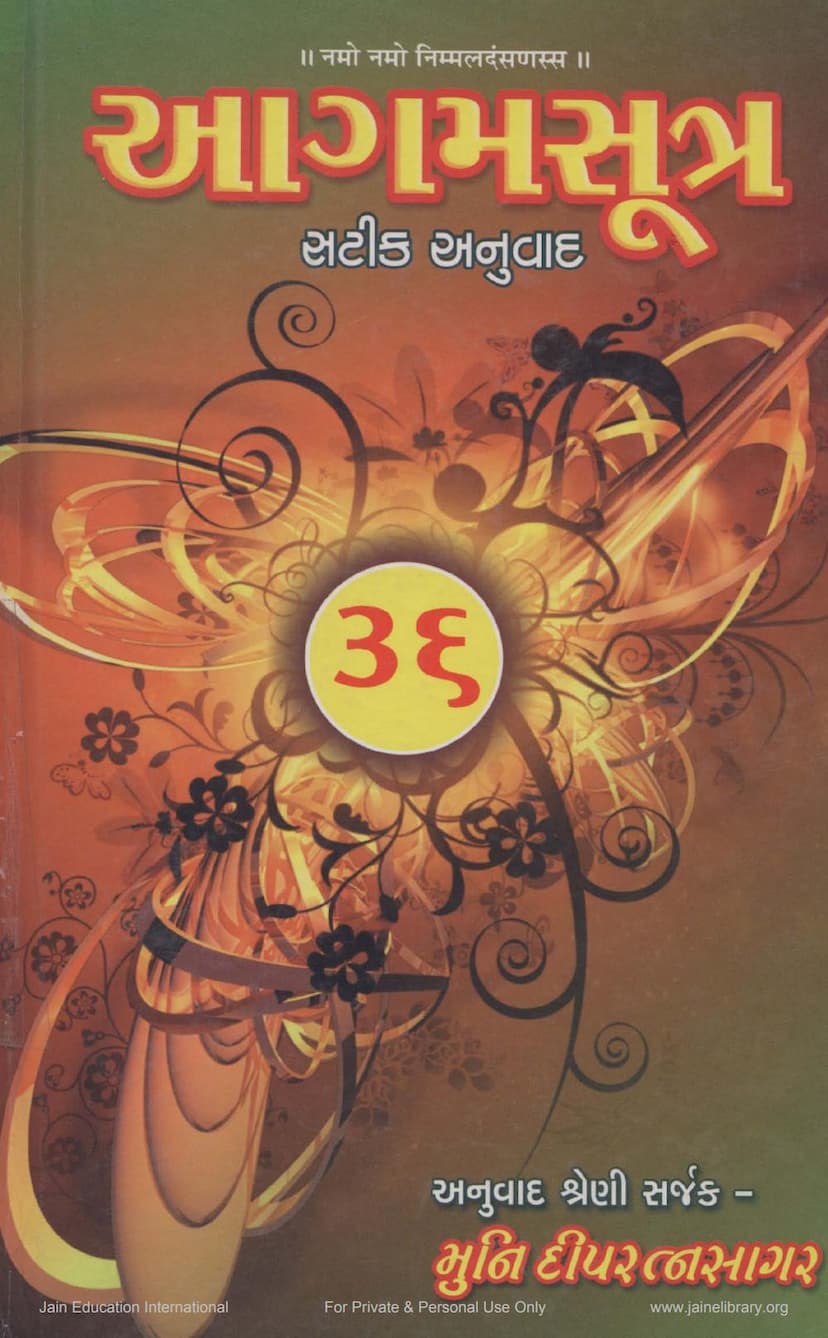Agam Satik Part 36 Dashvaikalik Sutra Gujarati Anuwad 1
Added to library: September 1, 2025

Summary
Here's a comprehensive summary of the provided Jain text, focusing on the Dashavaikalika Sutra (part of the Agam Sutra series):
Book Title: Agam Satik Part 36 Dashvaikalika Sutra Gujarati Anuwad 1 Author(s): Dipratnasagar, Deepratnasagar Publisher: Shrutnidhi Ahmedabad Catalog Link: https://jainqq.org/explore/009027/1
This document is the 36th part of a larger series titled "Agam Satik Anuwad" (Agam Sutras with Commentary and Translation), published by Shrutnidhi, Ahmedabad. This particular volume focuses on the Dashavaikalika Sutra, a foundational text within the Jain Agamas.
Content of this Volume (Part 36):
- Completeness: This volume contains the entirety of the Dashavaikalika Sutra, encompassing 10 Adhyayanas (chapters) and 2 Chulikas (appendices).
- Textual Basis: The summary includes the original Mula Sutra (root text), along with its Niryukti (glossary/etymological commentary), Bhashya (detailed commentary, specifically mentioning the Vritti by Haribhadrasuri), and excerpts from Churni (further commentary) by Jinvardhasuri and possibly Agatsyasingh Suri.
- Language and Purpose: The translation is in Gujarati, making the profound teachings of the Dashavaikalika Sutra accessible to those unfamiliar with Prakrit and Sanskrit. The aim is to facilitate the understanding and practice of Jain principles for spiritual seekers.
Introduction to the Dashavaikalika Sutra:
- Names: The text is known as Dashavaikalika in Sanskrit and Gujarati. In Prakrit, it is called Dasaveyaliya, and also sometimes referred to as Dasakalika.
- Structure: It comprises 10 Adhyayanas and 2 Chulikas.
- Focus: The primary focus of this Agama is Charana Karana Anuyoga, which deals with the practical aspects of monastic conduct and discipline.
- Origin: It was composed by Shyyambhavasuri for his son, Mankamuni, to guide him in the path of monastic life.
- Significance: This Agama is considered vitally useful for monastic life, detailing the rules and regulations for the conduct of monks. It is not merely for reading but for contemplation, application, and the daily routine of ascetics. The text covers the entire daily regimen of a monk. It's also mentioned that the rituals associated with this text (Yoga) are performed before conferring higher initiation (Upasthapana).
Key Themes and Content Discussed in the Translation (as evidenced by the provided text):
The translated text delves into the foundational concepts and their interpretation, starting with the initial auspicious invocation and the explanation of the author's intent. The initial sections cover:
- Mangala (Auspiciousness): Beginning with prayers and salutations to enlightened beings (Arhants, Siddhars).
- Niryukti and Commentary on Key Terms: The text meticulously breaks down the meaning of the title "Dashavaikalika" and related terms like "Niryukti" and "Anuyoga" (classification of Jain scriptures).
- The Importance of the Author and Lineage: Acknowledgement of the spiritual lineage of gurus and patrons who contributed to this translation and publication.
- The Nature of Jain Agamas: Discussing the importance of studying the Agamas, especially for those who are unable to access the original texts.
- Detailed Breakdown of the Dashavaikalika Sutra:
- The Title: The meaning of "Dashavaikalika" is explored, linking it to ten different aspects or times.
- Author and Purpose: The origin and purpose of the text, as a guide for monastic life, are highlighted.
- Monastic Conduct: The Dashavaikalika Sutra is presented as a manual for monks, covering their daily routines, ethical principles, and spiritual practices.
- Anuyogas: It emphasizes the importance of Charana Karana Anuyoga (practical conduct) and briefly touches upon the other Anuyogas (Dharma, Ganita, Dravya) as they relate to the text.
- Nityata and Anityata: The concept of permanence and impermanence in relation to spiritual truths is discussed.
- The Five Samitis and Three Guptis: These are fundamental Jain principles of careful conduct and restraint, likely elaborated upon in relation to monastic practice.
- Ethical Principles: The text discusses the avoidance of harm to the six life-forms (Shad Jivanikaya), the importance of non-violence (Ahimsa), and the practice of restraint (Sanyam).
- Tapas (Austerities): Various forms of austerities are mentioned as crucial for spiritual progress and purification.
- Purity in Alms-seeking (Bhagava): The text emphasizes the rules and etiquette for monks during alms-rounds, including the avoidance of impure food and the proper conduct when interacting with householders.
- The Ten Stages of Life/Conduct: The text categorizes life stages and the appropriate conduct within them.
- The Importance of the Guru: The role of the Guru in guiding the disciple is stressed, along with the virtues of a true disciple.
- The Purpose of the Agamas: The ultimate goal is liberation (Moksha), achieved through adherence to the teachings.
- The Five Vows (Maha Vratas) and Six Vratas: The core ethical principles for Jain ascetics are detailed.
- The Nature of the Soul and Karma: The text touches upon the nature of the soul and its interaction with karma, the cause of suffering and rebirth.
- The Path to Liberation: The principles of detachment, equanimity, and spiritual discipline are presented as essential for achieving liberation.
Overall, this volume provides a detailed and accessible Gujarati translation and commentary of the Dashavaikalika Sutra, offering profound insights into Jain monastic ethics, practices, and the path to spiritual liberation. The translation aims to make these ancient and crucial Jain teachings available to a wider audience.